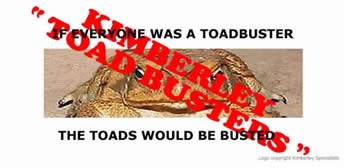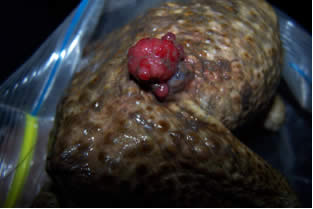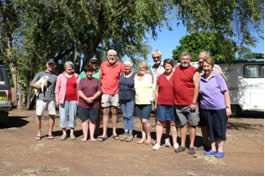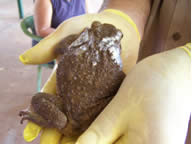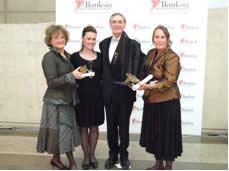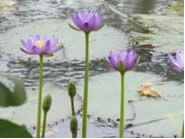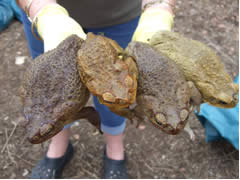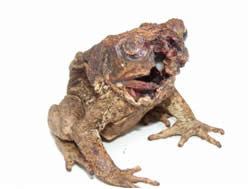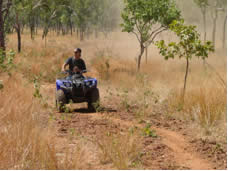A heartfelt cry from the Kununurra Community to the Nation. We will Stop the Cane Toads getting into WA! |
 |
 |
 |
 |
 |
|---|
KIMBERLEY TOAD BUSTERS NEWSLETTER No.18 27/07/2007 By Sandy Boulter (Volunteer Cane Toad Educator and Coordinator of the Perth based Friends of the Kimberley Toad Busters) and Lee Scott-Virtue (President and Volunteer Field Coordinator for the Kimberley Toad Busters)
WWW.CANE TOADS.COM.AU The Cane Toad is a Key Threatening Processto the Australian Nation Declared by the Federal Government 12 April 2005 This Newsletter is produced by Kimberley Specialists In Research Inc in conjunction with Kimberley Toad Buster Inc. Kimberley Specialists, a founding member of the Kimberley Toad Busters, continues to support the campaign against the cane toad by raising funds. KSR and KTB are tax deductible entities. IF EVERYONE WAS A TOADBUSTER kimberleytoadsbusters@canetoads.com.au www.kimberleyspecialists.com.au kimberleyspecialists@westnet.com.au Newsflashes!
|
If everyone was a toad buster, the toad would be busted! From President and Founding member of Kimberley Toad Busters Lee Scott-Virtue The unexpected late rains have moved the volunteer cane toad operations up a notch or two. Prior to the rains the toads had stopped moving, were showing no signs of major breeding and appeared to be present in much reduced numbers at the colonising fronts. This Newsletter No.18 brings us up to date with what has been happening at the cane toad front and with our remarkable KTBs generally over the last month. Some recent public statements coming from the some cane toad researchers are not supported by the KTB field results and observations. Our response is produced in this Newsletter, if for no other reason than to generate open healthy dialogue with others working in the field. KTB toadbuster leader and speleologist, Dave Woods has recently met with the DEC cane toad team. This will further improve our ability to reduce the workload by carefully allocating areas so there is no double up. Dave also is grateful for the new KTB GPS recorders which he says, “…will enable his team to accurately record their data in the field, and easily transfer and exchange information with the DEC team.” Thank you to everyone who continues to participate in and grow this remarkable campaign!
Vietnam Veterans and partners are Heroes and Heroines!
After leadership and toad busting training by the KTBs, the Vets established a permanent camp on one of the lagoon systems on Auvergne Station . This central location enabled the vets to toadbust several front line locations every night and day for four weeks. They recorded their data, autopsied toads, took lots of photos and caught thousands of toads. They were supported in the field by the KTB volunteers. The amazing benefits of their busting presence are just now being realised weeks after their departure. There has been no further westwards advance of the cane toads beyond the West Baines system and there is no breeding at this region of the front line. Since the Vets left, the KTBs have picked up only 5 cane toads on these frontline lagoons and only 2 cane toads from Duck Hole bore next to Snake Creek (7-8 kms from the West Baines). This is a wonderful result, which contributes significantly to slowing the advance of the cane toads. Clearly army strategy training is perfect undergraduate training for toadbusting! See on our website, the rather political Ode to toadbusting written by the Vets! Pollies take note… KTBs are Sending Cane Toads back to Queensland !
Dr Hayes says, “While the invasive nature of the cane toad is well known, what is not well understood is how toads use chemicals such as pheromones to communicate with each other. We are studying the chemical ecology of the cane toad, to develop a species-specific, environmentally benign control strategy for this invasive pest. The basis of this is to employ the toad's own chemical communication (pheromones) to disrupt mating and recruitment of the next generation to control the spread of this pest species. This sort of technique is, by its very nature, highly specific within a species, and will have no impact on native frog populations. “As part of this study we need to compare the chemistry of the toad at the invasion front to that in well-established populations in Queensland . We know there are differences in these populations in leg-length and parasites, but are there differences in their chemistry ?” As far as helping the Kimberley Toad Busters in the field with this research, Dr Hayes says, “In addition, we are studying the toxins in the cane toad secretions. What are the components that are so toxic, and how do they vary? Are toads at the invasion front more or less toxic than those in Queensland ? Some of these toxins occur in very low concentrations, and we need a large number of toads to collect enough material to test this toxicity and to identify them chemically. The excellent work of the Kimberly Toad Busters is removing hundreds of toads each week, many more animals than we can access in Brisbane . “Using pheromones to attract toads may see increased trapping success in traps baited with the odours. Depending on the nature of the pheromones we might also be able to repel toads from ecologically important water bodies. If we were to inoculate a specific waterway with a pheromone to keep toads away, it is possible that we might find a way to use this information to safeguard sensitive streams, rivers, lakes etc.” The KTBs are working through the logistics of collecting and forwarding the frozen dead toads on dry ice. The Friends have made sponsorship requests for transporting the cane toads. Anyone who can help with this important project can contact Sandy on 0427 508 582 or Lee on 91682576.. We wish Andrew well with his research. KTBs win Banksia Environment Community of the Year for 2007 Award! “Only in Australia could you win an environmental award for killing something! ” … overheard (in an American drawl), at the prestigious Banksia Environmental Awards Dinner last Friday night… The categories in which we were finalists were the Banksia Community Award and Banksia Landcare & Biodiversity Award. In addition to the above, Kimberley Toad Busters were one of the nine finalists (out of 49) in the running for the 2007 Banksia People’s Choice Award and were finalists in the Banksia Gold Award.
Pictured: Sandy, Paige and Sharon with Mark Stone, CEO Parks Victoria who we thank for sponsoring this Award KTBs thank Chief Patron of the Banksia Environmental Awards, our Prime Minister, the Hon. John Howard MP, the Board and Staff of the Banksia Environment Awards and Parks Victoria for sponsoring the Community Award, and congratulate the distinguished company of our fellow finalists and winners, including Arnold Schwarzenegger! We have a close connection with one of our fellow finalists, Conservation Volunteers Australia, who supported us with a group of hardy volunteers to help our toadbusting. KTBs thank toadbusters Sharon McLachlan and Sandy Boulter, and junior toadbuster warrior Paige McLachlan, who represented us at the awards ceremony. Words of support from Olympians Ian Thorpe and Alicia Camplin for the Banksia work were welcomed by all the finalists. See: www.banksiafdn.com for more information and photos TO RECAP : Through our own unique partnerships with the indigenous and non- indigenous men, women, teenagers and children working “on country”, the hardy and committed KTB volunteers have:
In April 2005 the federal government, represented at the Banksia Awards last Friday night by the Honourable Malcolm Turnbull MP, declared Bufo Marinus (the cane toad) to be a national threat to Australia ’s biodiversity . Recent modelling shows that every mainland capital city of Australia and most of our coastline could sustain the cane toad, which has now spread from the cane fields of Queensland (where they were introduced from Hawaii 71 years ago) to 83 kms from the WA/NT border and just north of Sydney. In urban societies, the toad will also kill our pets, and pollute our fresh water supplies and swimming pools. So very well done to all our 1,650 registered volunteers and supporters who are out catching cane toads who each share part of this accolade!!! Response to Scientific Statements About Cane Toad Cannibalism
In response to recently aired/published scientific comment about cane toad cannibalism, the Kimberley Toad Busters, who have been toadbusting at the colonising front every weekend since 20 September 2005 (nearly two years!) wish to reiterate some of our field observations published in our earlier newsletters and media releases:
Our field evidence and observations leads us to believe that there is as yet no valid scientific reason to leave the males at this colonising front, and so we will keep catching, killing and burying, male and female cane toads. Cane Toads and Burning
“This toad may have been burnt, but I suspect that the majority of its facial injuries are the result of a predator attack. We have had many of our radio tracked toads killed by predators that attack the eyes and the underside of the head. Note on your toad the broken jaw bone, right eye driven through into the oral cavity and the completely missing throat skin (and left lower jaw?). “We suspect that both birds (particularly night herons) and rats (particularly water rats) may be responsible for these attacks on toads. Thank you for your insights Ben and taking time out to forward your comments to us. This interaction is important for increasing our understanding of cane toads and their behaviour at the colonising front. Cave Systems, Cane Toads and Troglobytic Fauna
Pictured: Toadbuster, Chris Shaw on federally funded Quad Bike. Chris is often out toadbusting with Dave Wood’s team. Funding The WA State government has decided to undertake a review its cane toad operations. The review is being undertaken by an independent expert Professor Tony Peacock from the University of Canberra based Invasive Animals Cooperative Research Centre. The CRC motto is particularly apt to Toad Busting: Together, create and apply solutions Professor Peacock visited Kununurra and went toadbusting with the KTBs. DEC Perth held a cane toad forum while Professor Peacock was in Perth . Friends of the KTB members Paddy and John Weaver, and Michael Boulter attended the forum to represent the KTBs. It was at this forum that the theories about cane toad cannibalism were presented and postulated that it might be better to leave male cane toads in the field (see above for the KTB response). While this cane toad review has been taking place, Minister Templeman has decided to provide interim funding of $36,000 to the KTBs to assist them financially during the course of this review. These funds will primarily fund the recurrent weekly costs of toadbusting which have risen to be as high as $5,000 a weekend. Clearly, now that we have over 1,650 volunteers registered for toadbusting and have several colonising corridors over an area of over 120,000 square kms - this is almost like a military exercise and it is very costly, notwithstanding the fact that we are all volunteers. Friends of the Kimberley Toad Busters Up-date The Friends keep up their support from Perth for the field work of the KTBs by making presentations to schools, rotary club, Probus club and 4WD clubs. The Friends continue to draft media releases, assist with newsletters, liaise with government and ministerial offices in Perth , and write funding applications. Perth Friends can be contacted for KTB presentations in Perth and the South West of WA on phone 0427 508 582. The Friends have just submitted a Lotterywest application for the KTBs. Raffle Tickets
IF EVERYONE BECAME A TOAD BUSTER THE TOADS WOULD BE BUSTED! ALL DONATIONS ARE TAX DEDUCTIBLE kimberleyspecialists@westnet.com.au kimberleytoadbusters@canetoads.com.au Lee or Dean on 08 9168 2576; or Sarah Brett 0407 691 229 |


